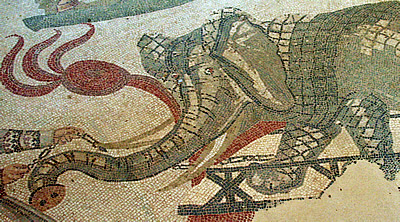

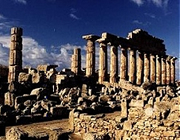
Sicily is fascinating. Over the centuries it has been ruled over by many different peoples who have all left their mark: pre-historic tombs in their thousands, Greek theatres and magnificent temples and an amazing aristocratic Roman villa with room after room of fabulous mosaics.
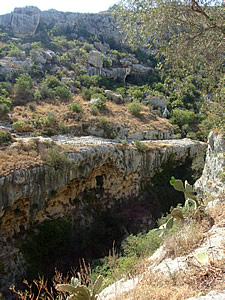
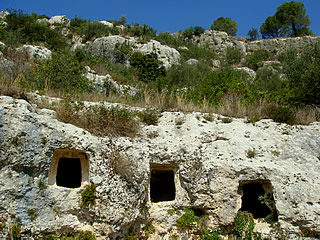
Because of Sicily's strategic location out into the Mediterranean off the tip of Italy it has been invaded many times. As early as 1100 B.C. the indigenous Sicani were being pushed east from their north-western home by the Elymians who had invaded the island, possibly from Anatolia. They in turn pushed the Siceli further east - they had arrived from mainland Sicily in about 1200 B.C.
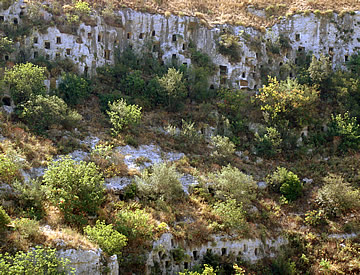
The Sicels retreated to more inaccessible sites in the hills and it was they who created the vast necropolis at Pantalica. More than 5000 tombs dating from the Bronze to the Iron Ages are scattered among the ravines.
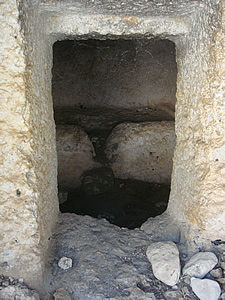
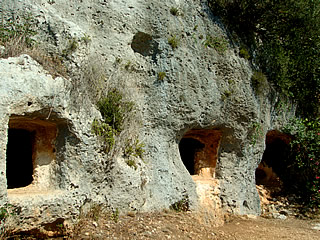
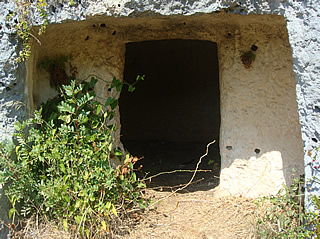
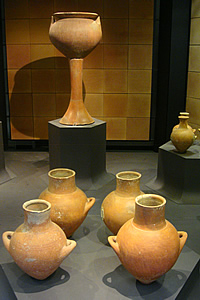
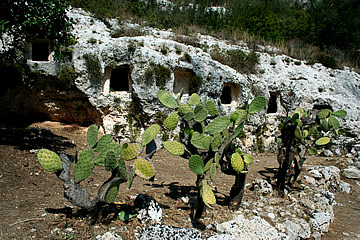
On another extremely hot day we explored the Northern necropolis. It's downhill all the way so we were wary of going too far and being very tired coming out. It's a great wal, though. Full of interest with lots of tombs to see both close to and on the opposite side of the gorge.
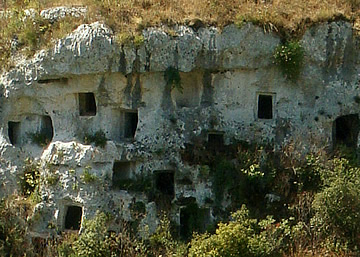
The tombs had been made with care. They were not just holes hacked into the rock but usually a recessed square or rectanguar shape leading into a space with vertical walls.
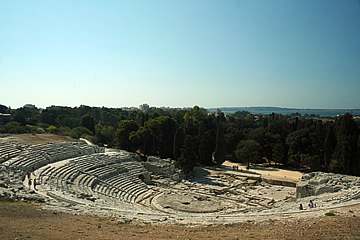
Phoenicians arrived around the eighth century B.C. trading their famous purple dye from coastal settlements with the Greeks. The dye was made from crushed seashells and the Greeks gave the traders the name by which we know them, it means "purple people".
The Phoenicians were peaceful settlers, colonising the west and south coasts while the Greeks settled in the east coast from around the same time. The Greeks expanded south and east, establishing centres at Syracuse, Selinunte and Agrigento among others and Phoenician trading posts eventually fell to the Carthaginians.
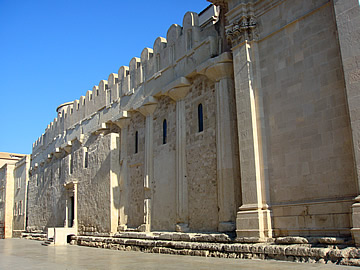
Around 734B. Syracuse became one of the first Greek cities to be founded. Remnants of the Greek heritage can be seen most obviously in the north of the present city at the archaeological park with its Greek theatre.
The lovely island of Ortigia at the southern tip of Syracuse has its Greek remnants too, notably columns from the Temple of Athena which can still be seen in the Baroque cathedral.
Syracuse is described in more detail here.
The Greek colonists were so successful that they moved steadily further west creating more towns such as Selinunte in 630B.C and Agrigento in 580B.C.
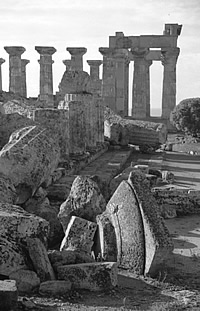
Selinunte, the most western Greek settlement, was in constant feuding with its northern neighbour Segesta and sacked by the Carthaginians, allies of the people of Segesta, in 409 B.C. Over the following centuries Selinunte changed hands several times between the Greeks and the Carthaginians until finally, around 250 B.C. during the First Punic War between Rome and Carthage, in what sounds like a fit of exasperation, Carthage removed all of the citizens of Selinunte and destroyed the city. The magnificent temples succumbed to an earthquake two hundred years later.
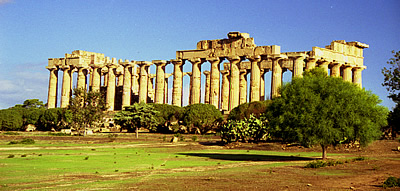
In 1998 entry was L.4000 via a brand new building at the car park. A short walk brings you to the eastern complex, a longer walk to the western end, or you can drive to another convenient car park. It looked like the area was being developed to cater better for tourists but the development is sensitive to the importance of the site and its situation.
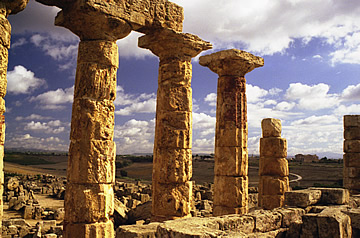
The huge stones lie where they fell, most impressively at the eastern end of the site where the devastation can be viewed from the raised steps of the only temple which has been reconstructed to a certain extent, the Temple of Hera.
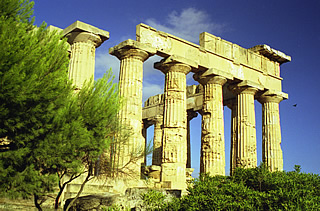
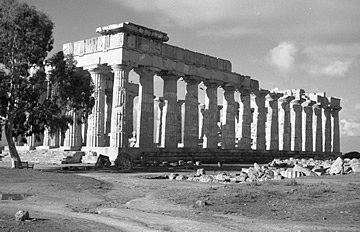
This site, which was outside but close to the town, originally had three impressive temples and most of the columns look as if they still lie where they fell. These were some of the largest temples in antiquity, greater than the Temple of Neptune at Paestum for instance, and the whole site most have been amazingly impressive - the ruins extend over a vast area.
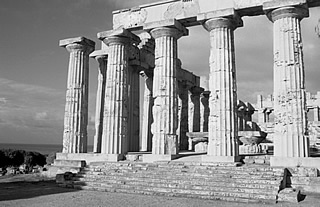

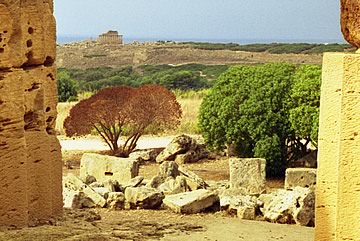
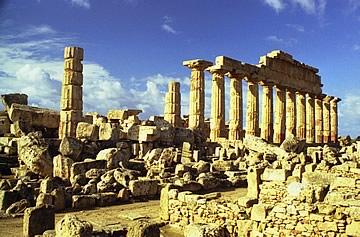
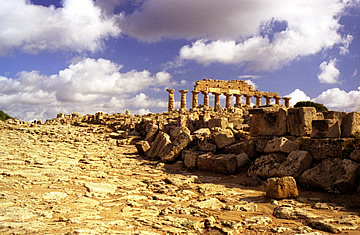
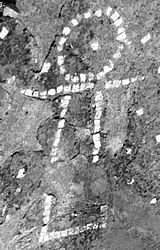
The western part of the site - the Acropolis - was walled and has the remains of the earliest town as well as more temples. The broad roadways speak of a prosperous community, confident in its strength, the magnificent temple ruins a sign of their devotion to their gods.
Mosaics at the entrance of Punic (Carthaginian) houses in Selinunte: below a bull, and on the right the Punic goddess Tanit.
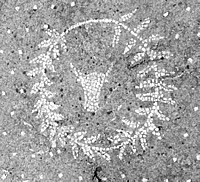

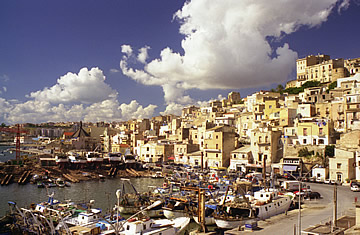
Sciacca was founded by the Greeks in the fifth century B.C. as a spa town for Selinunte. Today it is quite large and an active fishing port. The main town lies above the busy port area and has plenty of restaurants, cafes and ice cream shops. It makes quite a good base for visits to the major temple complexes. The ancient gateways into this walled town are still standing and the Piazza Scandaliato is the scene of a well-attended passegiatta every evening. Steep steps lead down to the port where there are more places to eat. We saw very little evidence of tourism here (1998) and enjoyed the atmosphere of this attractive, thriving, working town.
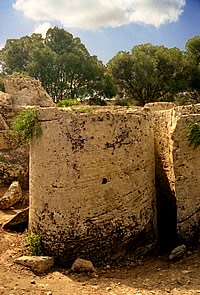
We visited the stone quarries at the Cave de Cusa where Selinunte sourced material for its buildings but didn't really find it very informative.
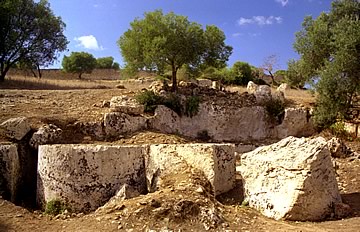
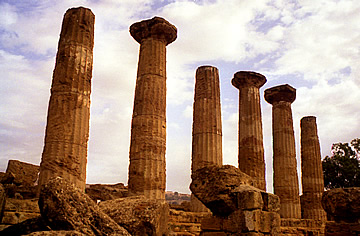
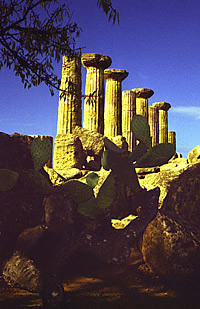
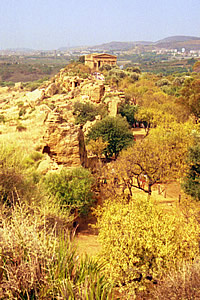
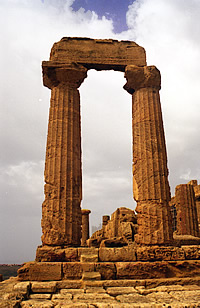
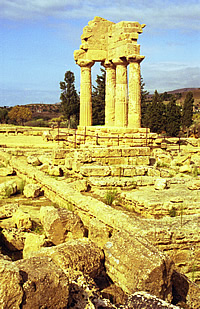
Agrigento is probably the best-known of the temple sites in Sicily.
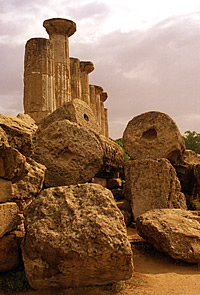
The ancient walled city of Akragas was founded by colonists from Gela in 582 B.C. between the two rivers Hypsas and Akragas. It consisted of a long temple ridge facing the sea with the city a little to the north-west backed by a second ridge to the north - the ancient acropolis - on which the modern town now stands. In 406 B.C. the Carthaginians plundered this wealthy city and burned its temples and, although it was later partly rebuilt, it never regained its former glory.
The ruins occupy two zones: the eastern zone on the ridge which is unenclosed, and an enclosed zone to the west where a charge is made for entry. The magnificent Doric temples on the ridge - known as the Valley of the Temples - must have been a wonder of their time and the full impact of the site is better appreciated from a distance south-east or north-west.
The first temple - also the oldest here - on the western end of the ridge is the Temple of Herakles, built at the end of the 6th century B.C.
Eight of its 38 columns were re-erected by the English owner of the nearby Villa Aurea in 1923. There is something rather atmospheric about these isolated columns in a sea of rubble.
Early Christian catacombs line the road between the Temples of Herakles and Concord.
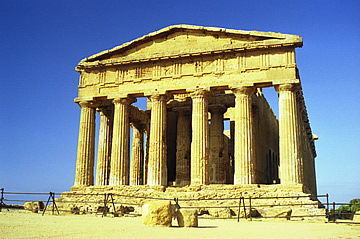
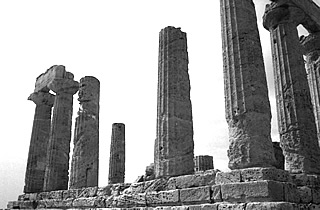
The central temple on the ridge, the Temple of Concord, is the best preserved of the three. Built around 430 B.C. it was used as a church in the middle ages and the arches of the internal cella - the sacred home of the deity - date from this period.
The Temple of Juno stands on a precipice at the far eastern edge of the ridge; a few columns, wall fragments, the temple base and re-constructed altar are all that remain.
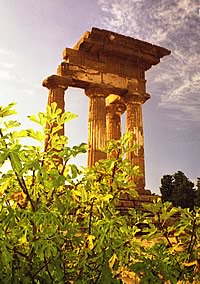
The western zone lies across the road close to the car park and kiosks.
The Temple of Zeus was one of the largest temples of antiquity, second only to the Artemision at Ephesus. Begun about 480 B.C. it was never completed; damaged by the Carthaginians and earthquakes all that remains are the remnants of walls and piles of stone.
Further on stands the so-called Temple of Castor and Pollux - although re-constructed from disparate fragments it is an attractive ruin.
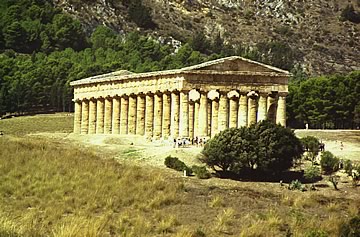
The Greek Temple at Segesta is in the extreme north west of Sicily but worth visiting if you get the chance.
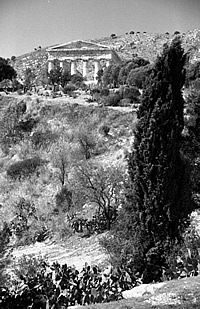
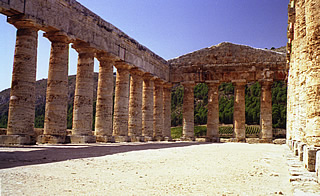
We were staying in the south of Sicily at Sciacca (1998), but flew in to Palermo so decided to visit Segesta on the way. Getting the hire car out of the parking area was the first problem, someone having parked in front of the exit - in true Italian style we ignored all signs and drove out of the entrance! Finding the motorway was the next problem - we could see it OK but were unable to get onto it without the help of an airport official escort. Thereafter the road to Segesta was no problem at all, a straight run through to this magnificent temple isolated high above the valley.
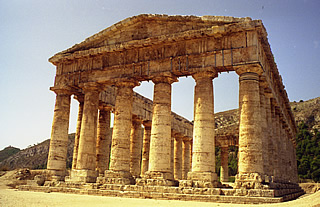
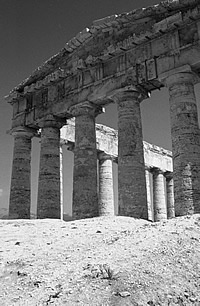
This beatiful shell of a Doric temple high on a hillside lacks a roof but all of the columns are standing. Not much more was ever in place as the temple was never finished. Started in 424 B.C. construction was halted 8 years later when a dispute broke out with Selinunte. In 1998 entrance to the temple site was L4000, tickets bought from a hut on a deserted patch of ground well away from the car park and shop/cafe.
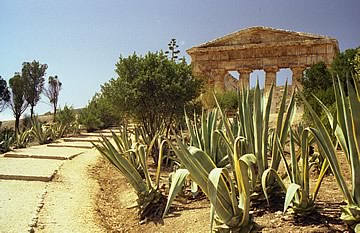
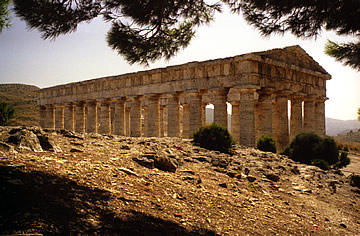
Segesta was the dominant city in this part of the island during Greek rule, having been important since the ime of the Elymian people. It was in almost constant conflict with Greek Selinunte.
The walk up to the temple is reasonably steep - it was an incredibly hot day when we visited here so perhaps we were deceived. The temple dwarfs the visitors who swarm all over it but if you wait until lunch time all of the coach parties miraculously disappear.
Below the temple is a shop and cafe and here we had out first taste of Sicilian wine; unfortunately this was of the local Marsala type which I dislike intensely.
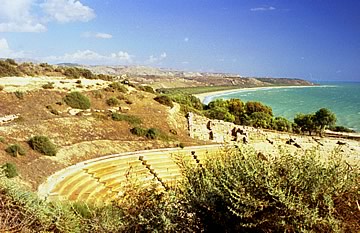
There had been some kind of settlement at Eraclea Minoa since prehistoric times and it was a Phoenician base before the Greeks arrived in the sixth century B.C.
The Greek theatre, built in the third century B.C. is set in a spectacular position on a ridge high above a curving bay. At first we were a little disappointed, (1998), mainly because we didn't realise that the theatre was covered in thick plastic - photographs come out very well and make it look like stone! I believe the plastic has gone but the whole theatre is protected by a covering. Some kind of protection is essential as the theatre is made from a very soft stone.

Its strategic location meant that over the centuries it changed hands many times. The Romans conquered in the third century B.C after which it decined in importance until it was eventually abandoned probably some time toward the end of the first century B.C. The excavations of houses are quite fascinating - only one or two visible at this time but well-preserved.
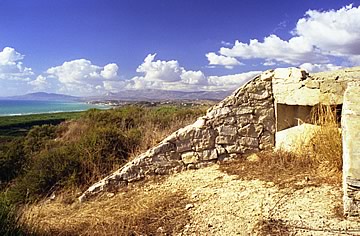
The town's name derives from local legends of Heracles and King Minos of Crete.
The World War Two pill-box on the promontory is also of interest but beware the snakes which are said to infest this area!
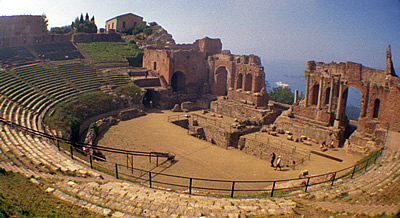
The Carthaginians were often called on to support local populations against Greek-held territories, for instance in Segesta's disputes with Selinunte. By the third century B.C. they had established a garrison in Messina. Rome was emerging as a powere in the region and, having once been an ally of the Carthaginians, now sent an expedition force to Sicily in 264 B.C. This was the beginning of the First Punic War. At the end of the Third Punic War, 146B.C. the victorious Romans razed Carthage, legend has it the land was ploughed over and sown with salt. Sicily was now the hands of Rome and was ruthlessly exploited for the production of grain to feed an ever-growing population in Rome. Sicilans became slaves in their own land, farming for Roman masters. Slave rebellion was not usually successful and could end with a shipment of slaves to Rome to provide "entertainment" fighting lions in the games.
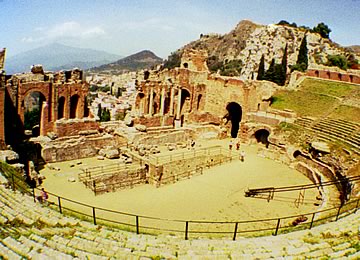
At the north-eastern end of the island the main attraction of the village of Taormina is the theatre built into the hillside by the Greeks in the third century B.C. It was rebuilt by the Romans towards the end of the first century A.D. and much of what remains is attributable to this rebuilding.
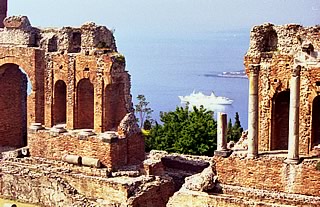
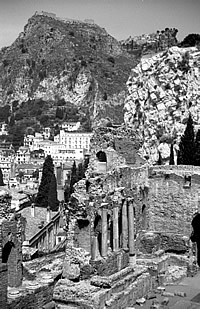
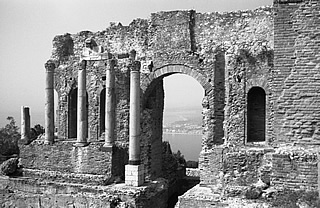
From here there are very good views of Etna, the Sicilian shore, and across the Ionian Sea to Calabria.
An amazing Roman villa can be found in Sicily, the Villa Romana del Casale. It has a wealth of wonderfully preserved mosaic floors and is described in detail on its own page: Villa Romana del Casale.
